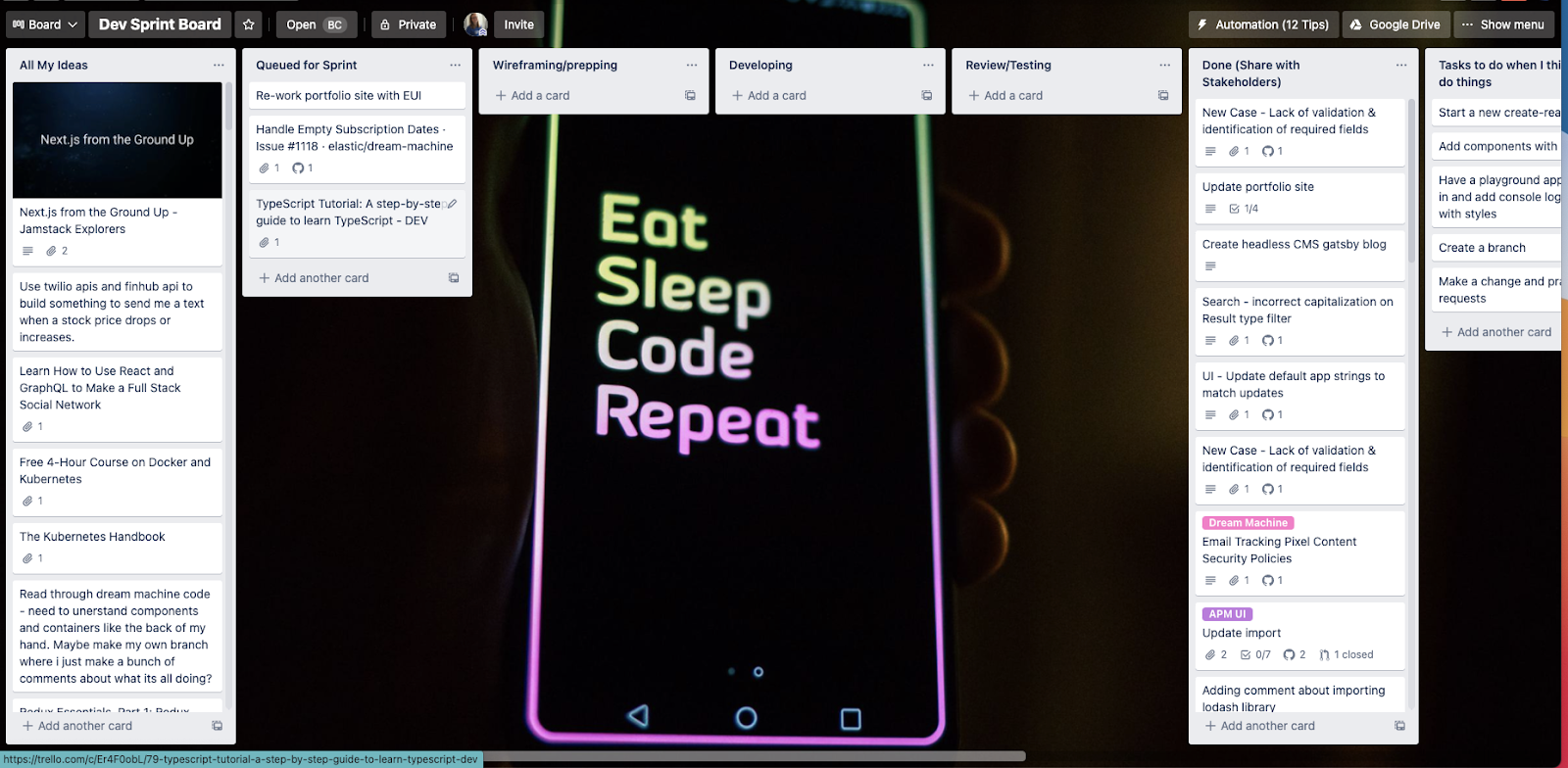Did you know the average person changes their career more than 5 times during their lifetime?
It’s a little scary to think about making a career change, but a few years ago I decided that even though I enjoyed my marketing career, it wasn’t the end goal for me. It was a difficult decision as I’d spent the last several years—and my college education—focused on marketing. I had no idea what it would be like figuring out what was next and how to get there.
By documenting everything and wrapping my brain around a plan, I was able to feel confident and make progress. And it paid off.
This summer I was able to finally make a transition from a marketer to a developer! It wasn’t a quick or simple journey, and my hope is that by sharing the ways I kept myself organized on my mission, I can help others in the same situation. I used Trello for nearly every step of the way, from crafting a plan to assembling all the items needed to crafting a resume for the job offer that I recently accepted!
It all starts by getting your thoughts out of your head and onto paper. (Or… Trello in this case.)
It All Starts With A Plan
If you’re about to make a career change, you might feel like you’re in a constant game of limbo. Regardless of if you know exactly where you want to go or if you’re unsure of what’s next—one thing is for sure—where you currently are isn’t where you want to be.
Choosing A New Career
While discovering the perfect career for you will surely take some introspection and in-depth research, there are a few easy ways to get the wheels spinning. Start by checking out What Color is Your Parachute, an excellent book on designing your ideal career. You can also take career aptitude tests to help you see what jobs you might be most likely to enjoy.
Start by creating a Trello board for organizing any ideas that come to mind of possible career options. Use the Custom Fields Power-Up to add context and details to your cards that will help you sort and compare your possible ideas.
For instance, you might want custom information like salary range, education required, or ability to work remotely. Then, create a list for each career option, and add cards for the pros and cons of each one. This will help you view all your options and compare them at a glance.

I knew I wanted to be able to work remotely and didn’t want to have to go back to school. I also knew I wanted something a little more technical (more left-brain-oriented). By looking at careers that fit those criteria, programming seemed to be a perfect fit.
Make The Plan
Once you’ve got an idea change that you want to make, it’s time to form a plan to put it into action. They say “a goal without a plan is just a wish”.
Do some research to see what is needed for you to make that career change. Does it involve going back to school or completing certifications? Are there any internship requirements? What activities can you do to test the waters and confirm this is the direction you want to take?
Create a board with a list of milestones and specific dates that you want to make progress. You can also create lists for any classes or educational requirements, and another list for possible places you can intern or volunteer. You can even add a mentor to this board to help you stay accountable for accomplishing these tasks.
Make Your Plan Actionable
Breaking projects down into their smallest pieces not only increases the likelihood you’ll accomplish them, it helps you be more productive. Take your action plan and create cards for tangible actions that build up to those bigger milestones.
I joined a programming bootcamp and created cards for each unit and chapter in the course . I found it helpful for keeping track of notes and references from specific lessons. Searching in Trello is much easier than trying to remember everything I learn. I added the emoji to my “Done” list, because I love getting that satisfactory confetti spray every time I complete a lesson and move it over.

Most career changes require you to get your hands a little dirty. Make a board for your career change that tracks any activities you’re doing, like internships, volunteering, or anything else that relates to your field. This will be super handy for creating a resume later. You don’t need anything fancy—a simple kanban board will do!
Although a formal programming education is rarely required for a developer job, there’s an expectation to build projects and show you know your way around various languages and frameworks. I created a “Developer Sprint Board” to come up with project ideas and tutorials that I wanted to work through to gain experience.

Organize Your Resources
Making a career transition today is easier than ever thanks to all the information we can access on the internet. If there’s a specific subject you want to learn more about—like programming—all you have to do is go to Google and you can find articles, podcasts, books, and blogs to help you learn more.
I subscribed to several blogs, newsletters, and podcasts on programming, and it quickly became a little overwhelming to keep track of all the things I wanted to remember down the road. I created a Trello board to keep track of them all so I could easily reference it and share with others. Whenever I’d come across something I wanted to remember later, like a syntax cheat sheet, or a tutorial on a subject I hadn’t studied yet, I saved it to my Developer Resource board.

Pro tip: It’s very easy to add items to this board on your mobile device, as you can just click “Share” on a webpage and send it to a Trello board and list. (Note: if you don’t see this as a share option, you might need to configure your share settings on your device.)
You can see I’ve added some friends to my board because learning works better together. Share this board with friends if you know anyone else on a similar journey, or you can make this resource public so other people can find your resources.
Prepping Your Resume
As you’re making a career change, you’ll develop a variety of skills and work on a handful of projects that you’ll want to make sure you highlight to potential employers. I found Trello to be extremely helpful for organizing all of the tutorials and projects I did so that when I wanted to create my resume, I just needed to organize all the cards on my board into a website!
You can create lists to organize all the information you might want to show on your resume, such as any certifications you complete, specific skills, courses, or any projects.

New Career, New You
Hey, pat yourself on the back. Just by reading this post, you’ve already taken a step towards making that career change. Hopefully, you’re feeling a little more confident and maybe a little more organized to get started. The best tip for making a career change? Find a supportive community – whether that’s your family, friends, or a mentor, to help encourage you along the way. There’ll be ups and downs, but as long as you keep your eye on the goal and keep making steps in that direction, you’ll get there!





 )
) 




































